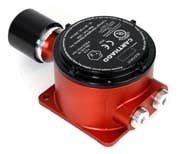OptoAcoustic gas detection determines gas content via the measurement of acoustic pressure waves that are propagated as a gas is irradiated under an appropriately tuned light. A gaseous mixture sample passes through a membrane into a measurement cell, which contains an optical light source and a microphone. Incident light modulated at a specific frequency is briefly absorbed as intermolecular energy by the gas molecules and then released as translational energy, creating periodic temperature and pressure changes that generate measurable acoustic pulses.
Carthagos proprietary OptoAcoustic Gas Sensor GLD-OA-01 (Patent US 7,213,444 B2) is comprised of two separate and identical cells that act interchangeably either as the primary gas-measurement cell or as a secondary compensation cell. This novel dual-cell design eliminates the need for calibration, making the sensor operational 60 seconds after being connected to a power source, as well as minimizing the potential for false positives or missed leaks. The secondary cell is also used as a redundancy measure - Industrys First Redundant Gas Sensor with active sensing element plus backup sensing element - in the event of primary cell failure. Embedded with compensation algorithms that provide immunity from up to 95% humidity and temperatures under 150°F, the device is capable of continuously monitoring combustible gas leaks in a measurement range of 0100% of the Lower Explosion Limit.
The gas sensor has been engineered to sustain harsh industrial conditions where they withstand vibration, temperature, and humidity extremes. The sensor requires less frequent maintenance due essentially to its self-diagnostics and false alarm rejection algorithms. As its design includes no materials that are consumed during the detection process, the sensor promises an extended and consistently accurate lifetime of up to 15 years.
In addition to the already available hydrocarbon version and a CO2 version with a concentration range of up to 50,000 ppm, the firm plans to release units for HCl, NH3 and H2S within the next 12 years.





